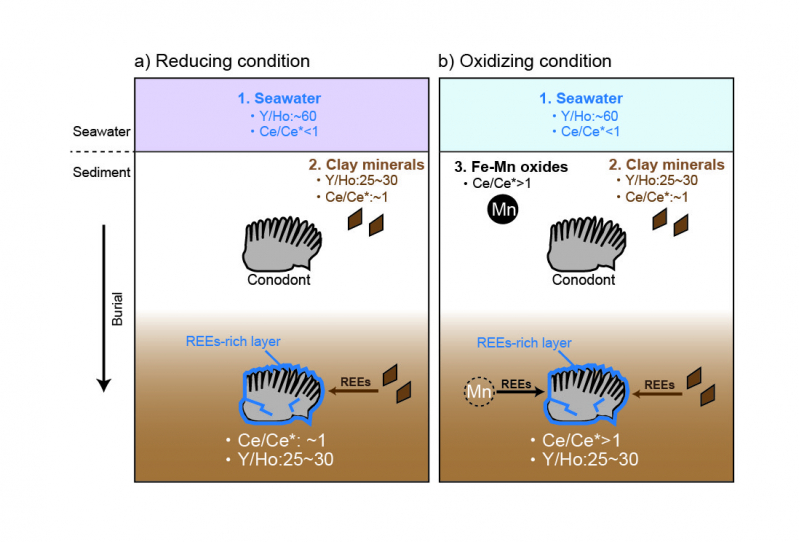
REE geochemistry of conodont fossils from pelagic deep-sea sedimentary rocks
ABSTRACT

Conodonts are tooth-like apparatuses of extinct marine animals and their geochemical composition is a key tool in reconstructions of paleo-marine environmental conditions. Previous geochemical studies focused on conodont fossils with weak thermal maturation from shallow-marine sedimentary rocks. However, the geochemical features of conodont fossils in pelagic deep-sea sedimentary rocks, which are suitable for reconstructions of paleo-environmental conditions of pelagic Panthalassa, are poorly understood. This study presents geochemical data of conodont fossils from the Triassic deep-sea pelagic sedimentary rocks from the Inuyama area, central Japan and examines their potential as a paleo-environmental indicator. The examined conodonts were composed of fluorapatite and possessed almost the same major elemental fractions as conodonts from Early Triassic limestone. Concentrations of REEs in conodonts in the pelagic deep-sea sedimentary rocks (~1000 ppm in average) are much higher than that of the conodonts from limestone (~89 ppm in average). Cathodoluminescence images and elemental mapping of conodont cross-sections reveal that conodonts in pelagic deep-sea sedimentary rocks have a few μm-thick REEs-rich layers composed of diagenetically precipitated euhedral apatite at the surfaces of the denticles and along cracks. Furthermore, Y/Ho ratios and Ce anomalies of the conodont fossils are different from those of modern seawater and, instead, are similar to those of the surrounding siliceous sedimentary matrix. These results suggest that their REE signatures were acquired from the surrounding siliceous material during diagenesis. The Ce anomalies of conodonts could reflect the presence of Fe-Mn oxides at the paleo-sea floor and indirectly record the redox condition of paleo-ocean floor.
KEYWORDS
Keywords: chert, Ce anomaly, diagenesis, Inuyama, TriassicSupplementary Materials(file)
https://www.jstage.jst.go.jp/article/geochemj/57/6/57_GJ23017/_supplement/_download/57_GJ23017_1.pdf
- Published : 2023
- Released on J-STAGE : 2023/12/22
- Received : 2023/07/10
- Accepted : 2023/11/11
- DOI : https://doi.org/10.2343/geochemj.GJ23017
- J-STAGE URL : https://www.jstage.jst.go.jp/article/geochemj/57/6/57_GJ23017/_article
- J-Online ISSN: 1880-5973
- Print ISSN : 0016-7002
- ISSN-L : 0016-7002
All Issues
- Vol.59, 2025
- Vol.58, 2024
- Vol.57, 2023
- Vol.56, 2022
- Vol.55, 2021
- Vol.54, 2020
- Vol.53, 2019
- Vol.52, 2018
- Vol.51, 2017
- Vol.50, 2016
- Vol.49, 2015
- Vol.48, 2014
- Vol.47, 2013
- Vol.46, 2012
- Vol.45, 2011
- Vol.44, 2010
- Vol.43, 2009
- Vol.42, 2008
- Vol.41, 2007
- Vol.40, 2006
- Vol.39, 2005
- Vol.38, 2004
- Vol.37, 2003
- Vol.36, 2002
- Vol.35, 2001
- Vol.34, 2000
- Vol.33, 1999
- Vol.32, 1998
- Vol.31, 1997
- Vol.30, 1996
- Vol.29, 1995
- Vol.28, 1994
- Vol.27, 1993
- Vol.26, 1992
- Vol.25, 1991
- Vol.24, 1990
- Vol.23, 1989
- Vol.22, 1988
- Vol.21, 1987
- Vol.20, 1986
- Vol.19, 1985-1986
- Vol.18, 1984
- Vol.17, 1983
- Vol.16, 1982
- Vol.15, 1981
- Vol.14, 1980
- Vol.13, 1979
- Vol.12, 1978
- Vol.11, 1977
- Vol.10, 1976
- Vol.9, 1975
- Vol.8, 1974
- Vol.7, 1973
- Vol.6, 1972-1973
- Vol.5, 1971
- Vol.4, 1970-1971
- Vol.3, 1969-1970
- Vol.2, 1968
- Vol.1, 1966-1967




